Background
Polybrominated diphenyl ethers (PBDE) were one of the most widely used groups of brominated flame retardants (BFRs). BFRs reduce fire hazards by interfering with the combustion of polymeric materials. PBDEs were first used in the 1970s and between 1970 and 2000 it has been estimated that approximately 12,000 – 15,000 tonnes of penta-BDEs were produced in Europe. PBDEs are persistent, bioaccumulative and toxic and due to concerns about their environmental impact they were banned in Europe in 2004. Since the ban their main sources are from the disposal of PBDE treated products.
PBDEs often associate with marine sediments, where they remain in lower layers unless the sediments are disturbed. PBDEs can also accumulate in shellfish and fish, where they are taken in either directly from the marine environment or indirectly through food consumption.
Analysis of PBDE in sediment and biota (fish and shellfish) is required for the OSPAR Coordinated Environmental Monitoring Programme (CEMP) and the Marine Strategy Framework Directive (MSFD). To fulfill these monitoring commitments the monitoring of PBDEs in sediment and biota is undertaken in Scotland as part of the UK Clean Seas Environment Monitoring Programme (CSEMP) for 4 biogeographic regions (Figure 2): Irish Sea (Clyde and Solway), Minches and Western Scotland, Scottish Continental Shelf and Northern North Sea. See the Introduction to SMA2020 for more about the areas used.
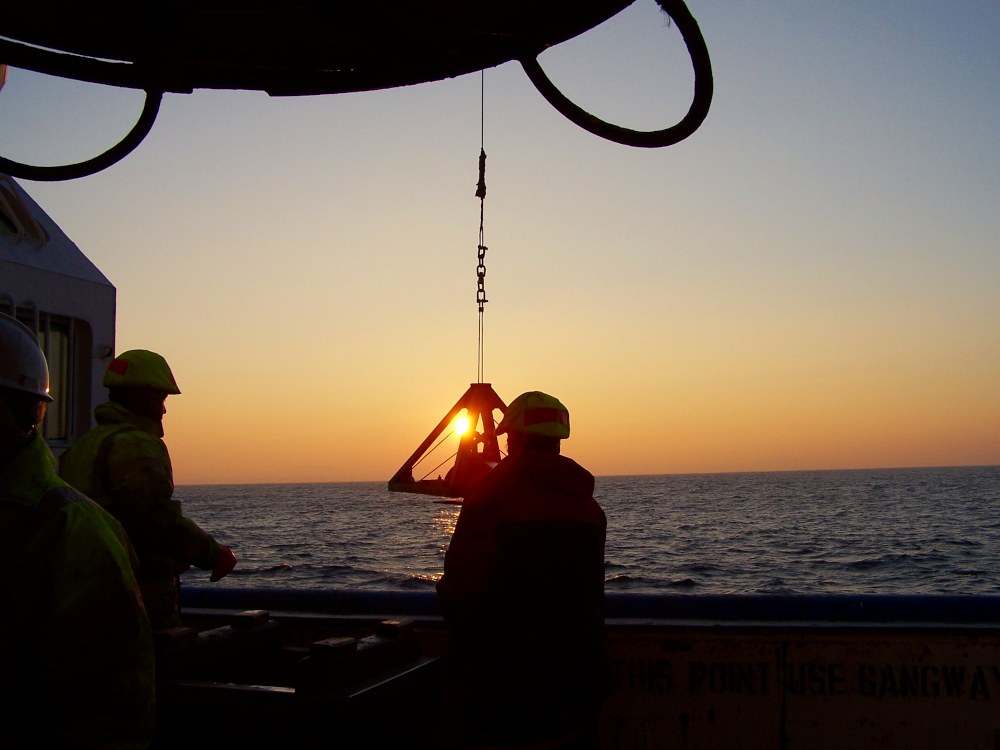
Figure 1: A day grab is used to collect sediment from the seabed for contaminant analysis. In this case the day grab was operated from the MRV Scotia.
Contaminants and effects monitoring is undertaken in Scottish coastal and offshore areas as part of the UK Clean Seas Environment Monitoring Programme (CSEMP). CSEMP is operated to ensure a coordinated monitoring programme across the United Kingdom. CSEMP contaminant and biological effects data are submitted to the UK Marine Environment Monitoring and Assessment National database (MERMAN) and from there to the International Council for the Exploration of the Sea (ICES) Environmental database.
The main focus of the CSEMP to date has been to meet the temporal trend monitoring requirements of the OSPAR Convention and of compliance with EC Directives such as Water Framework Directive (WFD) (Directive 2000/60/EC) and the Marine Strategy Framework Directive (MSFD) (Directive 2008/56/EC). The UK monitors substances detailed in the OSPAR Coordinated Environmental Monitoring Programme (CEMP) in sediment, fish and shellfish. The CEMP includes the monitoring of polycyclic aromatic hydrocarbons (9 parent PAHs), polychlorinated biphenyls (ICES7 PCBs), polybrominated diphenyl ethers (9 PBDE congeners) and heavy metals (Hg, Cd and Pb) in sediment and biota and tributyltin (TBT) in sediment.
The OSPAR Strategy for Hazardous Substances has a strategic objective which is to ‘Move towards the cessation of discharges, emissions and losses of hazardous substances by 2020 with the ultimate aim of achieving concentrations in the marine environment of near background for naturally occurring substances and close to zero for man-made substances’. Descriptor 8 (contaminants and their effects) is one of the eleven MSFD qualitative descriptors for determining Good Environmental Status (GES). To monitor compliance with GES for Descriptor 8, common indicators for contaminants and biological effects should be measured in environmental samples and compared to assessment criteria.
Commercial PBDE mixtures are classified according to their degree of bromination. The penta-BDE mixture was mainly used in furniture and upholstery, the octa-mixture in plastics and the deca-mixture in textiles. The use of penta- and octa-BDE technical mixtures was banned in Europe (EU Directive 2002/95/EC) in 2004 and an EU ban on the use of deca-BDE in electronics and electrical equipment became effective on 1 July 2008. Furthermore in March 2019 further restrictions were placed on the use of deca-BDE in products manufactured or placed on the market, including plastics and textiles, with the concentration of deca-BDE limited to 0.1 % by weight (EU 2017/227).
Historically, PBDEs were released to the environment during their production and through the manufacturing of products containing PBDEs. In the UK, penta and octa formulations of PBDEs were manufactured by the Great Lakes Chemical Company at Newton Aycliffe (County Durham), from 1996 until 2003 where high PBDE concentrations were found close to the plant. Between 1970 and 2000 it was estimated that approximately 12,000 – 15,000 tonnes of penta-BDEs were produced in Europe (Prevedouros, Jones & Sweetman, 2004).
Since the ban of BDE formulations, the main sources will be from the disposal of products containing these chemicals. In addition, PBDEs may continue to leak out of treated material during everyday use of ordinary consumer products, which has been documented by high PBDEs concentrations in the indoor environment. Losses of PBDEs have been documented from wastewater and stormwater discharges.
PBDEs have been found to concentrate in the Arctic and bioaccumulate in native animals and humans (deWit, M. Alaee & Muir, 2006), indicating long range atmospheric transport of PBDEs. PBDEs are one of the persistent organic pollutants (POPs) listed in the Stockholm Convention, and therefore steps must be taken to eliminate their production and use. In Scotland, PBDEs in the water environment are regulated as part of The Scotland River Basin District (Standards) Directions 2014, as implemented by the Scottish Environment Protection Agency (SEPA).
Animal studies have shown that PBDEs are endocrine disruptors, affect thyroid hormone functions and can impair the developing central nervous system and brain (Linares, Bellés & Domingo, 2015; Legler, 2008; Fernie et al., 2009; Costa & Giordano, 2007; Zhou et al., 2002). PBDEs bioaccumulate with the more highly brominated PBDEs (except for deca-BDE) being more likely to bioaccumulate because they have higher octanol-water partition coefficients than the lower brominated PBDEs (Darnerud et al., 2001).
There are 209 possible PBDE congeners. However, PBDE technical mixtures contain only a limited number of these congeners (~20). Nine of these (BDE28, BDE47, BDE66, BDE100, BDE99, BDE85, BDE154, BDE153, BDE183; ΣPBDE9) were selected, taking into account their occurrence in the environment and their toxicity, to be routinely determined as part of the OSPAR CEMP (OSPAR Commission, 2007). BDE209 should be monitored in sediment only, as it has a high affinity to bind to sediment and is less easily taken up by biota.
PBDE monitoring in sediment and biota (shellfish and fish liver) is undertaken in Scottish coastal (SEPA and Marine Scotland Science (MSS)) and offshore areas (MSS) as part of the CSEMP. WFD monitoring in coastal and transitional water bodies is undertaken by SEPA (mainly shellfish). Monitoring of organic contaminants such as PBDEs in water has largely stopped in Scotland as concentrations are generally at very low levels and difficult to detect. SEPA and MSS PBDE data in sediment and biota are submitted to MERMAN and have been used in this assessment.
The 2019 assessment of CSEMP data (1999 – 2018) describes the trends and status of contaminant concentrations at sediment and biota (shellfish and fish liver) monitoring stations in the four Scottish biogeographic regions. Assessments are made for many time series, each of a single contaminant at a single monitoring station. This section describes how the results of the individual time series are synthesised to assess status and trends at the biogeographic regional level (Table a). Five PBDE compounds for which assessment criteria were available, were assessed for status and trends (Table b).
Assessment scales
Status and trends assessments were conducted for the 4 biogeographic regions. Figure 2a and b shows all the monitoring stations where there are suitable data for sediment and biota, with the magenta dots showing stations used for trend and status assessments and cyan dots showing stations where there is only status information. The areas delineated by the grey lines are the biogeographic regions. The number of stations in each biogeographic region is given in Table a.
|
Scottish Biogeographic Region
|
Sediment
|
Biota (shellfish and fish)
|
||
|
Trends
|
Status
|
Trends
|
Status
|
|
|
Irish Sea (Clyde and Solway)
|
6
|
7
|
9
|
12
|
|
Minches and Western Scotland
|
2
|
5
|
1
|
3
|
|
Scottish Continental Shelf
|
0
|
1
|
0
|
0
|
|
Northern North Sea
|
5
|
15
|
4
|
10
|
Assessment of concentrations of PBDEs in sediment and biota (shellfish and fish liver)
PBDE compounds are monitored in sediment and biota (shellfish and fish liver) as part of the CSEMP. Sampling and chemical analysis methodologies met the relevant OSPAR requirements (OSPAR, 2008). Statistical assessments of status and trends were also based on OSPAR methodologies. Assessment criteria for PBDEs in sediment and biota have only recently been trialled as part of the 2017 OSPAR assessment (Table b). EACs are not available for PBDEs and therefore the Canadian Federal Environmental Quality Guidelines (FEQGs) were trialled as EAC-proxies (Environment Canada, 2006 & 2013).
The WFD introduced Environmental Quality Standards (EQS) for some contaminants in biota, including PBDEs. However, the EQS for PBDEs is a human health based threshold and is for the sum of 6 congeners. In addition, the EQS is below the limit of detection of methods often used to measure PBDE concentrations. Therefore, the PBDE EQS is considered too low for meaningful environmental assessments and has not been used in OSPAR and MSFD assessments.
|
|
Sediment
|
Biota
|
|||
|
BAC
(μg kg-1 dw)
|
FEQGs
(μg kg-1 dw)
|
BAC
(μg kg-1 ww)
bivalves
|
BAC
(μg kg-1 ww)
fish
|
FEQGs
(μg kg-1 ww)
|
|
|
BDE28
|
0.05
|
110
|
-
|
0.012
|
120
|
|
BDE47
|
0.05
|
97.5
|
0.011
|
0.012
|
44
|
|
BDE66
|
0.05
|
97.5
|
-
|
-
|
-
|
|
BDE85
|
0.05
|
1
|
-
|
-
|
-
|
|
BDE99
|
0.05
|
1
|
-
|
0.012
|
1
|
|
BDE100
|
0.05
|
1
|
-
|
0.012
|
1
|
|
BDE153
|
0.05
|
1,100
|
-
|
0.012
|
4
|
|
BDE154
|
0.05
|
1,100
|
-
|
0.012
|
4
|
|
BDE183
|
0.05
|
14,000
|
-
|
-
|
-
|
|
BDE209
|
0.05
|
47.5
|
-
|
-
|
-
|
Notes:
- BACs and FEQGs for sediment are normalised to 2.5% organic carbon.
An individual time series of PBDE concentrations is assessed for status if:
- there is at least one year with data in the period 2012 to 2017.
- there are at least three years of data over the whole-time series.
- a parametric model can be fitted to the data and used to estimate the mean concentration in the final monitoring year (or, occasionally, if a non-parametric test of status is applied).
The time series is also assessed for trends if, in addition:
- there are at least five years of data over the whole-time series.
- a parametric model can be fitted to the data and used to estimate the trend in mean concentrations.
Information on how the individual time series are assessed for status and trends can be found here: https://www.bodc.ac.uk/projects/data_management/uk/merman/assessments_and_data_access/csemp/
For the regional assessment, the results from the individual time series are combined. Essentially, a summary measure of status or trend is obtained from each time series. These are then modelled, using a linear mixed model, to estimate the mean status, or the mean trend in each biogeographic region. Only biogeographic regions with at least three monitoring stations with good geographic spread are considered in the regional assessment.
The trend analysis is further restricted to time series from monitoring stations that are classified as ‘representative’. ‘Baseline’ stations (those with near pristine conditions or only subject to very diffuse inputs) are omitted because any trends there will likely be caused by different processes to those at representative stations. Similarly, ‘impacted’ stations (those close to a point source) are omitted because trends there will likely reflect changes due to the point source, and will be ‘unrepresentative’ at the regional level. There are no restrictions on the time series used in the status analysis based on the classification of the monitoring station; time series from baseline, representative and impacted stations are all included.
Results
PBDE concentrations are measured in sediment and biota (shellfish and fish) samples taken between 1999 and 2018 from four biogeographic regions (Figure 2), in cycles varying from annually to every six years. Only biogeographic regions with at least three stations with a reasonable geographic spread were included in the regional assessment of status and trends. Shellfish (blue mussel) were collected in coastal and estuarine areas only whilst sediment and fish were collected from coastal and more offshore areas.
PBDE concentrations in sediment and biota (blue mussels and fish liver) were compared to the OSPAR Background Assessment Concentration (BAC). BACs are used to assess whether concentrations are close to zero for man-made occurring substances, such as PBDEs. In addition, PBDE concentrations in biota and sediment were compared to the Federal Environmental Quality Guidelines (FEQG). Adverse effects on marine organisms are rarely observed when concentrations are below the FEQG.
There were sufficient sites for a status assessment of sediment and biota (fish and shellfish) in the Irish Sea (Clyde and Solway) and Northern North Sea, as well as for sediment in the Minches and Western Scotland region. Trends could only be assessed in the Irish Sea (Clyde and Solway) and Northern North Sea for both sediment and biota. The highest PBDE concentrations in sediment and biota were in the Irish Sea (Clyde and Solway), which includes the Clyde, the most industrialised and urbanised Scottish sea area. PBDE concentrations in sediment, particularly in the offshore areas of the Northern North Sea, are low with most PBDE congeners being below the analytical detection limit. Across all PBDE congeners, the status assessment for sediment and biota was the same for all regions, with mean regional concentrations being above the BAC but below the FEQG (Figure 3). Therefore adverse biological effects in marine species are unlikely. However, 8 of 28 sediment sites and 7 out of 25 biota sites report concentrations of at least one PBDE congeners that are not acceptable (> FEQG).
Trends in PBDE concentrations were assessed in biogeographic regions where there were at least five years of data (Figure 4). Two regions were assessed for trends in sediment and biota. Across all PBDEs concentrations were stable in biota and sediment from the Northern North Sea. In the Irish Sea (Clyde and Solway) mean % yearly changes were negative (improving) in both matrices, with significant decreases in biota.
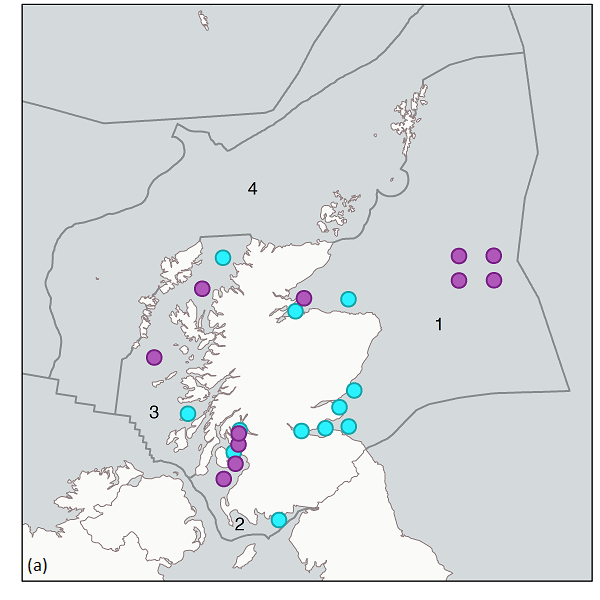

Figure 2: Monitoring stations used to assess PBDE concentrations in (a) sediment and (b) biota (shellfish and fish) per biogeographic region (grey lines). Magenta dots = stations used for trend and status assessments. Cyan dots = stations used for status assessment only. 1, Northern North Sea; 2, Irish Sea (Clyde and Solway); 3, Minches and Western Scotland; 4, Scottish Continental Shelf.
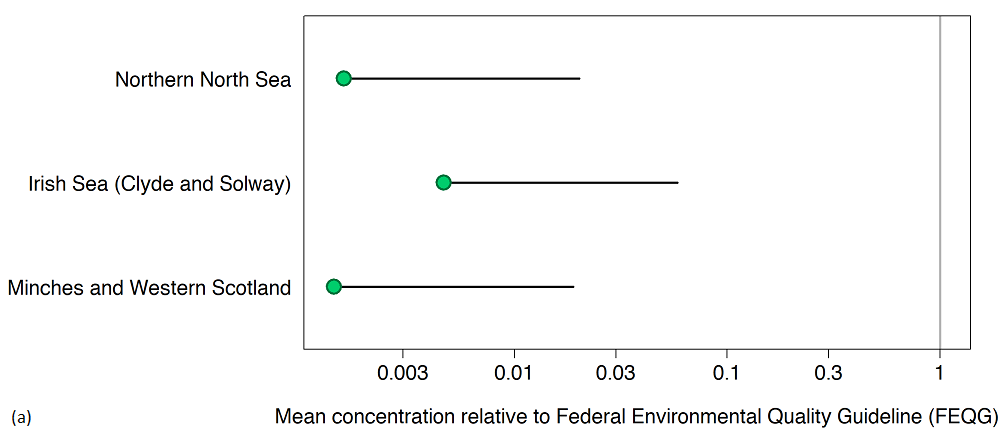
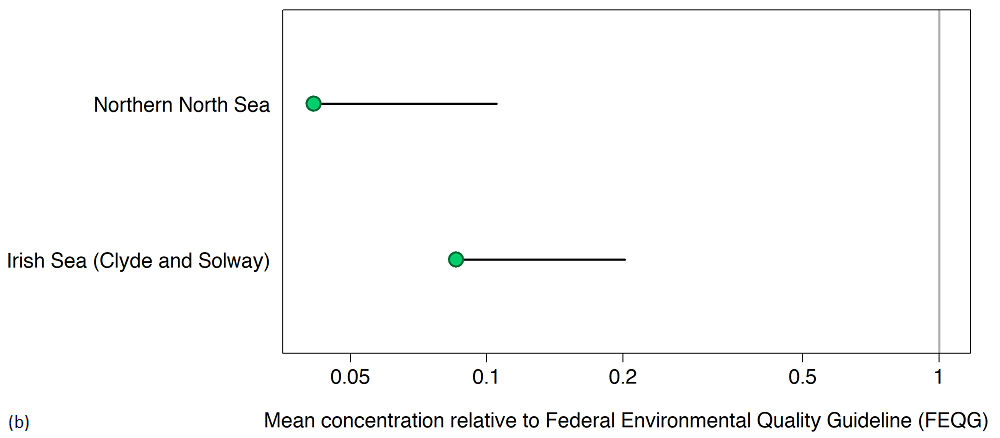
Figure 3: Status assessment; mean PBDE concentration in (a) sediment and (b) biota (shellfish and fish) in each Scottish biogeographic region relative to the FEQG (with 95% confidence limits), where the FEQG value is 1. Concentrations are significantly below the FEQG if the upper confidence limit is below 1. Blue = statistically significantly below the BAC. Green = at or above the BAC but statistically significantly below the FEQG.
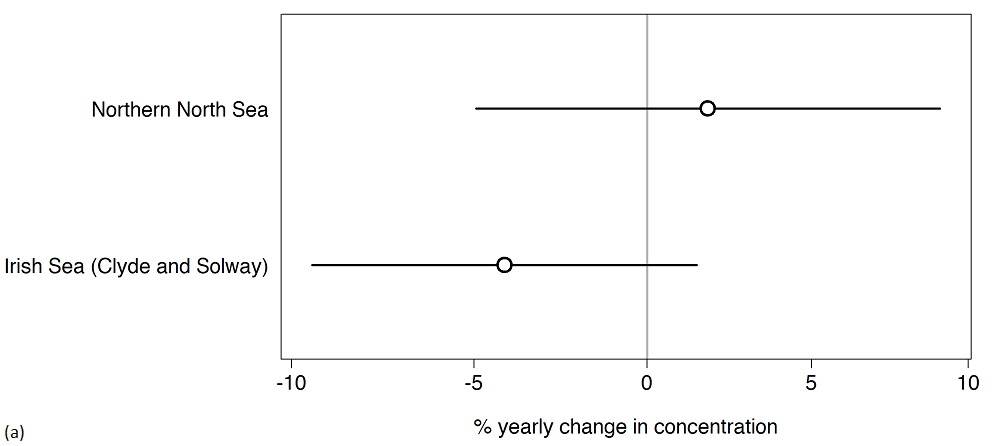
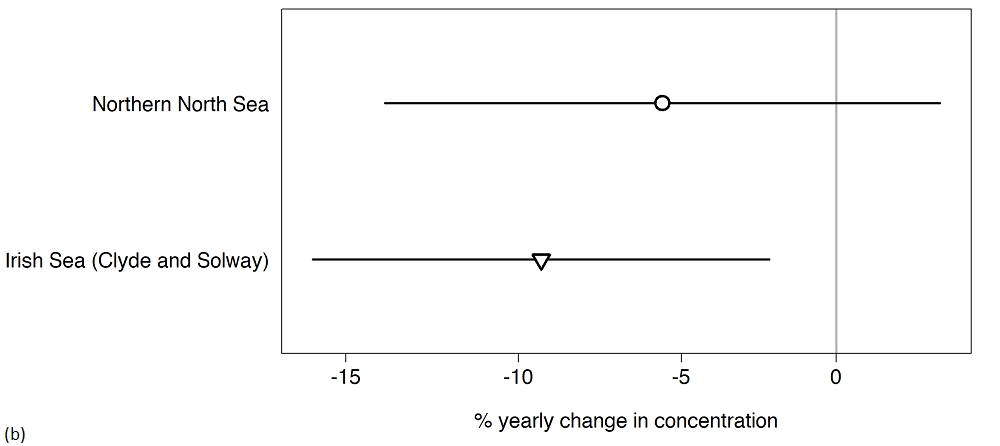
Figure 4: Trend assessment; percentage yearly change in PBDE concentrations in each Scottish biogeographic region for (a) sediment and (b) biota . There is a significant trend if the confidence limits does not cut the vertical line at 0. Upward trends (upwards triangle), downward trends (downwards triangle), no change (circle) and 95% confidence limits (lines).
MSS and SEPA PBDE data were used in the assessment, with laboratories complying with ISO 17025, being UKAS accredited (for most determinands) and participating in the QUASIMEME proficiency testing scheme. Therefore, there is high confidence in the quality of the data used in this assessment. The data have been collected over many years using established sampling methodologies. In addition, established and internationally recognised protocols for monitoring and assessment are used, therefore there is also high confidence in the methods. The assessment methodology has been developed and improved since the assessment for Scotland’s Marine Atlas (Baxter et al., 2011), with a regional assessment being undertaken and presented here rather than the individual station assessment presented in the 2011 Atlas. The status of PBDEs in sediment and biota was not assessed for Scotland’s Marine Atlas (2011), due to the lack of suitable assessment criteria. FEQGs were trialled in the 2017 OSPAR assessment and are used in this assessment.
PBDE concentrations were compared to the BAC and FEQG. FEQGs are available for five BDE congeners in sediment and biota. Mean individual PBDE concentrations (normalised to organic carbon for sediment) relative to the FEQG for each biogeographic region are shown in Figure a. The mean regional concentration relative to the BAC is shown in Figure b. PBDE concentrations in sediment and biota were highest in the Irish Sea (Clyde and Solway), which includes the Clyde, the most industrialised and urbanised Scottish sea area.
PBDE concentrations in sediment are low and frequently below the detection limits, particularly in the Northern North Sea and Minches and Western Scotland, where BDE47 and BDE209 were often the only BDEs detected. BDE154 was at background in sediment from the Northern North Sea.
Mean regional concentrations for individual PBDEs were significantly below the FEQG in all regions, except for BDE209 in sediment from the Irish Sea (Clyde and Solway). BDE209 is normally the dominant PBDE congener in sediment but rarely detected in biota and is the main component of the commercial deca-BDE products. Across all PBDEs, mean regional concentrations were below the FEQG and, therefore, overall adverse biological effects in marine species are unlikely in the assessed areas. Eight of 28 sediment sites and 7 out of 25 biota sites in the Irish Sea (Clyde and Solway) and Northern North Sea report concentrations of at least one PBDE compound that are not acceptable (> FEQG). However, if the EQS for PBDEs in biota was used in the status assessment then mean regional concentrations would exceed the EQS in both regions assessed.
A regional assessment of status for PBDEs in sediment and biota was not undertaken for Scotland’s Marine Atlas (2011), due to the lack of assessment criteria. In 2011 the low concentrations in the Northern North Sea and frequent PBDE detections in the Clyde were noted.
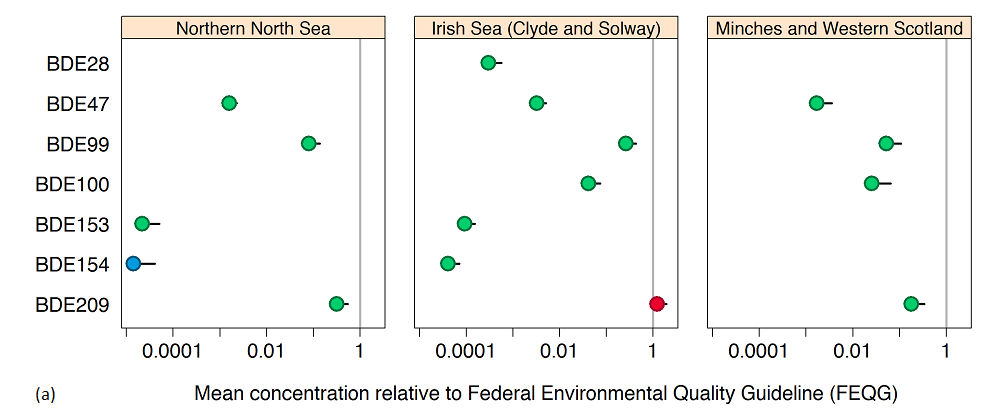
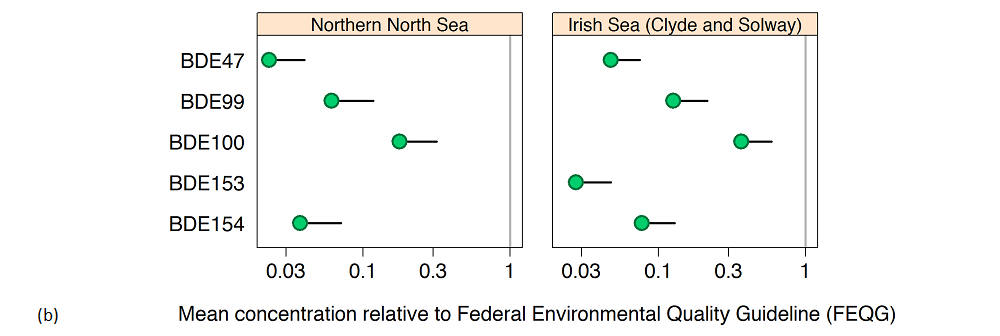
Figure a: Status assessment; mean PBDE concentration in (a) sediment and (b) biota (fish and shellfish) in each Scottish biogeographic regions, relative to the FEQG (with 95% confidence limits) where the FEQG value is 1. Concentrations are significantly below the FEQG if the upper confidence limit is below 1. Blue = statistically significantly below the BAC. Green = at or above the BAC but statistically significantly below the FEQG. Red = statistically significantly above the FEQG.
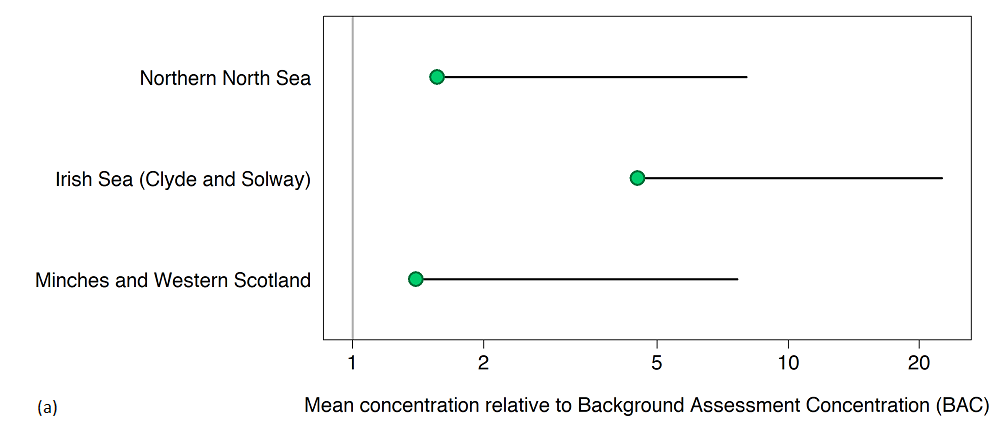
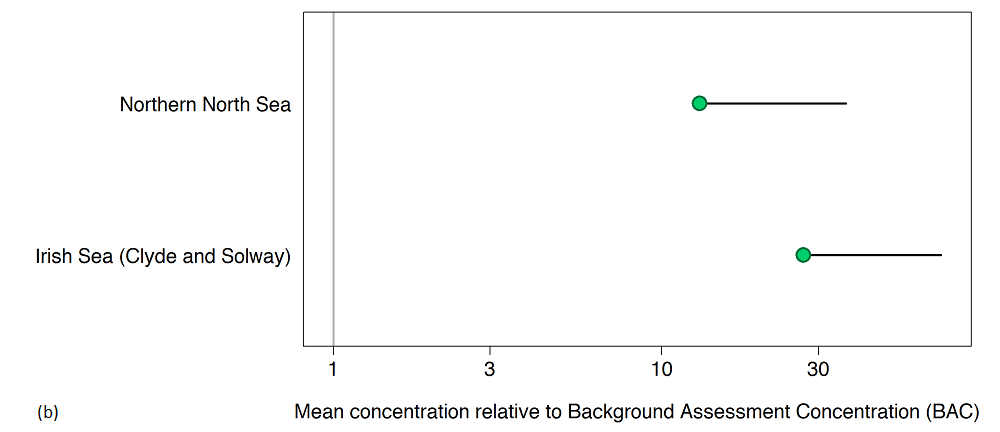
Figure b: Status assessment; mean PBDE concentration in (a) sediment and (b) biota (fish and shellfish) in each Scottish biogeographic region, relative to the BAC (with 95% confidence limits), where the BAC is 1. Concentrations are significantly below the BAC if the upper confidence limit is below 1. Blue = statistically significantly below the BAC. Green = at or above the BAC but statistically significantly below the FEQG. Red = statistically significantly above the FEQG.
Trends in PBDE concentrations were also assessed in regions where there were at least five years of data. The %-yearly change for individual PBDE compounds in each Scottish biogeographic region is shown in Figure c.
For sediment all PBDE congeners assessed showed negative yearly changes in the Irish Sea (Clyde and Solway).The mean percentage yearly reduction was 4.14% for the 3 PBDE congeners assessed, however none of these changes were significant. Only BDE47 was assessed in the Northern North Sea, as all other congeners were normally below detection limits, or there were insufficient number of years, and the mean %-yearly change was 1.83%.). All PBDE congeners in biota also showed reductions, with mean percentage yearly decreases ranging from 5.46% for BDE47 in the Northern North Sea to 9.45% for BDE100, in the Irish Sea (Clyde and Solway), with significant downwards trends for all 5 congeners assessed in the Irish Sea (Clyde and Solway).
Scotland’s Marine Atlas (2011) did not present any information on the trends of PBDEs in sediment and biota either by individual site or by Scottish Sea Areas. The overall conclusion for trends of hazardous substances in the 2011 Atlas was that concentrations in water, sediment and mussels were decreasing, but remained high in industrialised areas such as the Clyde and Forth.


Figure c: Trend assessment; mean annual trends in PBDE concentrations in (a) sediment and (b) biota (fish and shellfish) by biogeographic region and compound. There is a significant trend if the confidence limits does not cut the vertical line at 0. Upward trends (upwards triangle), downward trends (downwards triangle), no change (circle) and 95 % confidence limits (lines).
Scottish Marine Regions
Eleven Scottish Marine Regions (SMRs) were created by The Scottish Marine Regions Order 2015 which cover sea areas extending out to 12 nm. Regional assessments to support Regional Marine Plans are required to be developed for each SMR by the relevant Marine Planning Partnership.
The CSEMP sampling design is based on the biogeographic regions used within UK and MSFD assessments and therefore there are insufficient data for a regional assessment for all SMRs. In particular, some SMRs have no or few (<3) monitoring stations. For sediment, four of the eleven SMRs might have sufficient data for a regional assessment; Clyde, Forth and Tay, Moray Firth and West Highland. For biota, eight of the eleven SMRs (all but Orkney, North Coast and North East) might have sufficient data for a regional assessment. Further work is needed to undertake an assessment at the SMR level.
However, each SMR is contained within a biogeographic region or, in some cases, straddles two biogeographic regions (Shetland and Outer Hebrides). Table c shows the SMR and the biogeographic region(s) they are in. Using the biogeographic regional assessment of PBDEs, concentrations in sediment and biota are likely to be above background but below the FEQG in all SMRs. Concentrations are also likely to be stable or decreasing in all SMRs. Only the Clyde, and Forth and Tay showed some exceedances, mainly for BDE209 in sediment, where 5 of 6 stations in the Clyde and 2 of 3 stations in the Forth and Tay exceeded the FEQG. Concentrations above the FEQG were also observed for BDE99 and BDE100 at a few sediment and biota stations in both these areas.
Additional monitoring stations would be required to enable regional assessments in each SMR. This might be achievable for biota if the monitoring stations are increased. It is less likely to occur for sediment as it will be harder in some SMRs to find muddy areas suitable for contaminant monitoring. For example, much of the sediment in the Outer Hebrides, Orkney, North Coast and North East SMRs are sand, gravel or rock.
|
SMR
|
Biogeographic region
|
|
Argyll
|
Minches and Western Scotland
|
|
Clyde
|
Irish Sea (Clyde and Solway)
|
|
Forth and Tay
|
Northern North Sea
|
|
Moray Firth
|
Northern North Sea
|
|
North Coast
|
Scottish Continental Shelf
|
|
North East
|
Northern North Sea
|
|
Outer Hebrides
|
Scottish Continental Shelf
Minches and Western Scotland
|
|
Orkney Islands
|
Scottish Continental Shelf
|
|
Shetland Isles
|
Northern North Sea (east Shetland)
Scottish Continental Shelf (west Shetland)
|
|
Solway
|
Irish Sea (Clyde and Solway)
|
|
West Highlands
|
Minches and Western Scotland
|
Conclusion
PBDE concentrations are low, particularly for sediment in offshore areas, frequently being below detection limits. However, mean regional concentrations in sediment and biota (mussels and fish liver) were above background concentrations in the assessed Scottish biogeographic regions. Mean PBDE concentrations were below the FEQG in all regions and therefore are unlikely to cause adverse effects in marine organisms. Assessment of trends showed that PBDE concentrations in sediment and biota are stable or decreasing in all areas.
The most dominant PBDE in sediment, BDE209, exceeded the FEQG in the Irish Sea (Clyde and Solway), and therefore adverse effects on marine organisms may still be possible in this area. Due to past industrial uses and the persistence of PBDEs it will take several more decades before concentrations in sediment will disappear. The EQS for PBDEs in biota was not used in OSPAR or MSFD assessments and was not used in this assessment for the reasons outlined in the assessment method section. However, if used, then concentrations are likely to exceed this concentration at all sites.
The assessment methodology has been developed and improved since Scotland’s Marine Atlas (2011). Therefore a direct comparison to the 2011 assessment was not possible. A status assessment of PBDEs in sediment and biota was not undertaken in 2011 due to the lack of assessment criteria, the regional assessment model was not used and no statistical assessment of trends was undertaken.
The CSEMP sampling design was based around the biogeographic regions used in OSPAR and MSFD assessments, therefore there are insufficient data for status and trend assessments of all SMRs. Each SMR will be within a biogeographic region. In some SMRs there will be no or few stations, particularly for sediment, and regional assessments will not be possible without additional sampling.
Knowledge gaps
There are a lack of monitoring data, particularly for sediment in the Scottish Continental Shelf. This is partly due to difficulties sampling in this area and the sediment type which is mainly sandy or rock and therefore not suitable for contaminant monitoring.
The FEQG was used in the assessment as there are no OSPAR Environmental Assessment Criteria (EACs) currently available. There is a need for further development of EACs in sediment and biota.
There were insufficient data for the assessment of all SMRs. Since Scotland’s Marine Atlas (2011) and OSPAR Quality Status Report (OSPAR, 2010) the focus for annual CSEMP contaminant monitoring has been to establish sufficient coverage to make regional assessments at the biogeographic scale for OSPAR and MSFD assessments.
Additional sampling and analysis would be required if regional assessments were to be made for all SMRs. However the sediment type may not be suitable for contaminant analysis in all SMRs. In addition, shellfish sampling in all SMRs might not be possible, due to the lack of mussels in some areas. It may be possible to use PBDE data for scallops to improve the spatial coverage for regional assessments, MSS is currently investigating this.
Status and trend assessment
This status and trend assessment is an overall assessment for Contaminants in sediment and biota (PAHs, PCBs, PBDEs and metals in sediment and biota) and Biological effects of contaminants.
|
Region assessed
|
Status with confidence
|
Trend with confidence
|
Comments
|
|---|---|---|---|
|
Irish Sea (Clyde and Solway)
|
 |
|
Green square with red triangle for status indicates few or no concerns as a whole, but many local concerns, particularly in the Clyde, with some sites exceeding the EAC/EAC-proxy. Two stars for confidence in the status is due to lack of suitable assessment criteria for some determinands (metals in biota and some biological effects measurements)
|
|
Minches and Western Scotland
|
 |
|
Two stars for confidence in the status is due to lack of suitable assessment criteria for some determinands (metals in biota and some biological effects measurements). In addition there is limited fish sites which impacts on the ability to make biological effects assessments.
|
|
Northern North Sea
|
 |
|
Two stars for confidence in the status is due to lack of suitable assessment criteria for some determinands (metals in biota and some biological effects measurements)
|
|
Scottish Continental Shelf
|
 |
|
One star for confidence in the status is due to lack of suitable assessment criteria for some determinands (metals in biota and some biological effects measurements). In addition this region could not be assessed for all determinand/matrix combinations due to the lack of sites
|
This Legend block contains the key for the status and trend assessment, the confidence assessment and the assessment regions (SMRs and OMRs or other regions used). More information on the various regions used in SMA2020 is available on the Assessment processes and methods page.
Status and trend assessment
|
Status assessment
(for Clean and safe, Healthy and biologically diverse assessments)
|
Trend assessment
(for Clean and safe, Healthy and biologically diverse and Productive assessments)
|
||
|---|---|---|---|
 |
Many concerns |
No / little change |
|
 |
Some concerns |
Increasing |
|
 |
Few or no concerns |
Decreasing |
|
 |
Few or no concerns, but some local concerns |
No trend discernible |
|
 |
Few or no concerns, but many local concerns |
All trends | |
 |
Some concerns, but many local concerns |
||
 |
Lack of evidence / robust assessment criteria |
||
| Lack of regional evidence / robust assessment criteria, but no or few concerns for some local areas | |||
 |
Lack of regional evidence / robust assessment criteria, but some concerns for some local areas | ||
| Lack of regional evidence / robust assessment criteria, but many concerns for some local areas | |||
Confidence assessment
|
Symbol |
Confidence rating |
|---|---|
|
Low |
|
|
Medium |
|
|
High |

Assessment regions

Key: S1, Forth and Tay; S2, North East; S3, Moray Firth; S4 Orkney Islands, S5, Shetland Isles; S6, North Coast; S7, West Highlands; S8, Outer Hebrides; S9, Argyll; S10, Clyde; S11, Solway; O1, Long Forties, O2, Fladen and Moray Firth Offshore; O3, East Shetland Shelf; O4, North and West Shetland Shelf; O5, Faroe-Shetland Channel; O6, North Scotland Shelf; O7, Hebrides Shelf; O8, Bailey; O9, Rockall; O10, Hatton.




